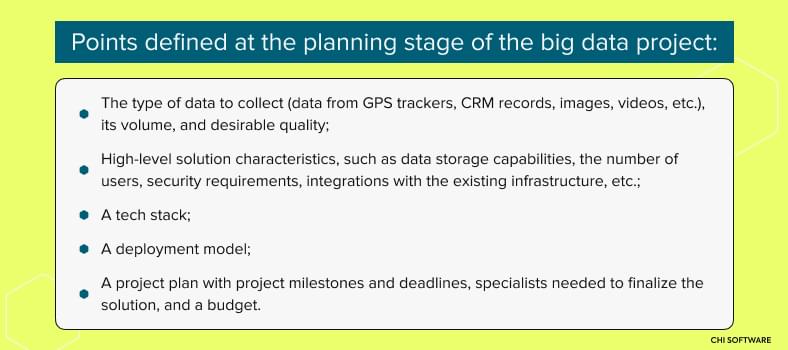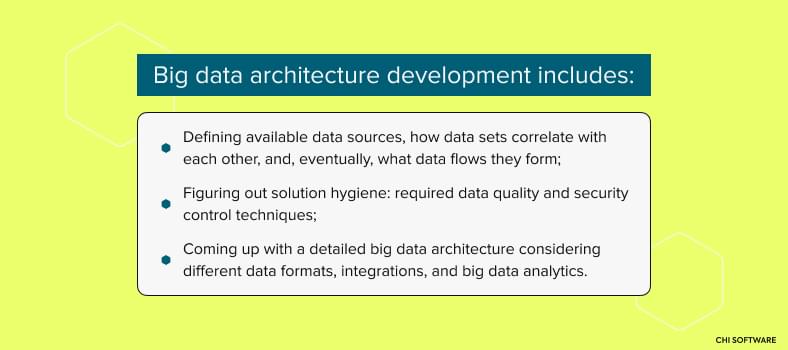While pandemic restrictions are being lifted, offline events are returning to our lives, and it's hard for us to part ways with digital. Just a month ago, I attended my first major offline tech conference since the pandemic’s start – IBC2022 in Amsterdam. As a part of the program, participants were offered an application that helped them navigate all the...
“Without big data analytics, companies are blind and deaf, wandering out onto the web like deer on a freeway”, – Geoffrey Moore, consultant and author.
The logistics industry is evolving in response to dynamic business trends and customer preferences. The workflow becomes more complex every year, resulting in process bottlenecks and extra costs. To keep logistics companies afloat and optimize their delivery, business owners have to consider innovations, and data science is one of them.
According to Grand View Research, the US supply chain analytics market is expected to grow at a 13.3% CAGR between 2022 and 2030. At the same time, Allied Market Research projects the global supply chain analytics market to reach 16.82 billion USD in 2027 compared to 4.53 billion USD in 2019.
In 2022, big data in logistics and supply chain management is by no means one of the best solutions for multiple business issues. We will explain why.
From this article, you will learn more about big data applications in logistics and how to implement them in your business ecosystem. We are also be sharing a pitch of our development experience to give you an idea of how it may work in practice.
Top 6 Data Science Applications in Logistics
Logistics companies have to handle vast data sets. Shipment origin and destination points, weight, size, and contents – these are only a small portion of the processed information. Companies also consider vehicle characteristics, fuel consumption, weather reports, traffic, and many other factors.
Let us not forget about transparency, strict schedules, and increasing customer expectations impacting transportation businesses. It indeed looks overwhelming. But it’s going to change. There use cases will give you an idea of how to harness possible complications with a big data solution.
1. Route optimization
Route optimization in logistics implies trying out several scenarios to pick the most cost-effective route. This process may result in minor management flaws which eventually lead to major business issues. Why is it happening?

To find the best route, one should consider numerous factors, like weather, traffic, or road conditions. No wonder managers sometimes make errors in their assumptions. But big data can remove or at least considerably reduce business risks by taking into account all necessary aspects and coming to an accurate conclusion. Your task is only to provide big data tools with essential information.
2. Transportation tracking
Big data analytics in logistics has brought transportation tracking to a whole new level. Companies and individual consumers can track their parcels in real time, getting automatic updates via email or app notifications.
Data from GPS-powered devices, bar codes, and advanced RFID (Radio Frequency Identification) tags enables big data solutions to track every package, plan delivery dates, and notify company managers and receivers if something does not go as planned.
Read also: How IoT impacts global logistics development
The latest IoT tracking tools help transportation companies keep a close eye on the temperature, humidity, and other conditions in the fleet. Data from sensors is particularly important when transporting perishable goods.
3. Optimization of last-mile delivery
Even though it is the last mile, it brings a lot of trouble to logistics businesses. Let us say, a big truck cannot park in an urban area. It means a courier has to walk some distance to deliver a package. And what if this package is heavy?
In such cases, workers have to spend extra time and effort to accomplish their tasks. It is only one real-life example out of many, which often get overlooked.

Implementing data science in logistics can dramatically change this and a lot of similar situations. Just by using information from GPS devices, big data software can track every step of the courier (literally) and identify delivery trends, regardless of the miles traveled. Company managers, in their turn, make data-driven decisions to improve internal processes and service quality.
4. Innovative warehouse management
With every innovation in online shopping, customers become more demanding. They want to know exactly what goods are available in stock and get them as soon as possible. Traditional warehouse management sometimes can’t handle increased workloads. Plus, some errors may emerge due to the human factor.
Big data solutions significantly improve existing logistics operations. With their help, company managers always have easy access to updated data about goods in stock, their locations, expiration dates, and other information. They won’t miss a thing and, hence, can satisfy demanding buyers and avoid overstocking.
5. Verifying address information
Delivering packages to wrong or even nonexistent addresses is another logistics pain point. Company clients are humans who naturally can make mistakes in indicating the delivery address. How can you solve such an issue?
Verifying every destination point by company employees is not an option. It eventually can lead to even more errors. What you should consider instead is using software tools.

Ideally, address records should be standardized and then validated. Standardization is the process of correcting records, while verification means checking if the address exists. You can do all that with a powerful big data solution at hand. It will help you decrease the human factor impact on your processes to a bare minimum.
6. Predictive maintenance
Data science in logistics opens the door to advanced analytics insights previously inaccessible to managers and decision-makers. From now on, they can monitor driver habits that directly impact fleet wear and spot damaging trends.
Read also: Our guide to data science in retail
Company employees can also track the car’s condition and plan maintenance in advance by collecting data from fleet sensors. Predictive analytics provided by big data tools is the key to fleet durability and reasonable use of business resources.
What Are the Main Advantages of Using Big Data in Logistics and Supply Chain Management?
Each of the use cases above causes major changes in the organization’s workflow and results achieved. This is exactly what will happen:
Your business will save a lot of money, time, and material resources. If the routes for your fleets are optimized, couriers do not get confused with wrong addresses, and vehicles are repaired on time, you will notice tangible changes in just several weeks. It gives you more room for maneuver in terms of strategic planning and resource reallocation.
Read also: How to implement computer vision across industries, including transportation
Your market reputation will improve. Big data allows you to track any shifts in customer behavior and be one step ahead of market trends. You can provide customers with the fastest and most accurate delivery to strengthen your competitive edge and increase customer loyalty in the long run.
You will achieve complete workflow transparency. No other technology can provide reports on every step walked by couriers and every mile passed by trucks. Big data solutions enable tireless 24/7 monitoring to help you identify small-scale process trends and deviations.
Now, let us see how applying big data looks in practice. In the next section, we will review the development process from start to finish.
How to Implement Big Data Analytics in Logistics and Supply Chain Management
When it comes to big data implementation, there is no one-size-fits-all approach. Every organization has a unique software ecosystem, goals to achieve, workflow issues, etc. However, some development stages do not change much. Here they are.
1. Studying & Preparing
Before getting to planning, a development team studies individual business characteristics, assesses the feasibility of the future solution, and calculates probable development costs.
Preparing necessary information in advance can significantly speed up this preparation process, so make sure to mention your goals, explain working processes, and clearly define workflow bottlenecks.
2. Planning
At this stage, developers and their clients go into detail, outlining specific software requirements. Taking some time for thorough planning at the beginning will save you from numerous risks, including overdue deadlines and extra costs.

3. Architecture Building
Big data solutions require extra effort at the stage of architecture building. These are the steps to take before coding starts.

4. Development & Testing
The development part begins. Typically, big data solutions for logistics have complex logic and cover several working processes. These are some of the most common software features to consider:
- Real-time tracking of fleets, goods, and couriers,
- Automatic invoicing,
- Comprehensive reporting,
- Data-based analytics, etc.
Needless to say, quality assurance and testing should take place at every development stage to make sure the system works as expected.
5. Deployment
Software deployment is the final step to make sure your software runs properly on specified devices and can be scaled in the future.
Note that big data solutions grow with your business. The more data comes to your organization, the more capabilities you will need for efficient data management. This is why deployment plays a fundamental role in the entire development process.
It all may seem complicated when explained in general terms. Let us review a real-life case study to see “before” and “after” more clearly.
How Does Big Data Implementation Look in Practice? CHI Software Experience
CHI Software is developing an advanced VHM (Vehicle Health Management) system based on AI technology. Our client is a well-known provider of AI-driven automotive software headquartered in Israel.
Project background
The client’s representatives reached out to our team intending to reduce costs for car maintenance using a VHM system*. But there is a catch. Such systems notify users only after a certain issue has already occurred. Our client wanted to go further and know beforehand if something may go wrong.
*A VHM system is a set of sensors located in different car parts and software receiving signals from these sensors.
Our solution
The optimal solution for the client’s needs is an AI-powered tool that can process hundreds of signals in real time. It covers three main tasks:
- Monitoring the car’s state,
- Identifying and predicting issues,
- Suggesting maintenance options.
What else is being done:
- A CHI Software data scientist is developing deep learning models allowing unsupervised anomaly detection;
- She is also working on automated machine learning (ML) solutions based on synthetically-created anomalous data;
- Our ML engineer receives models from data scientists and runs them on the big data solution, along with cloud-based calculations.
What are the results so far?
- Using this powerful big data tool, our client can detect anomalies with the highest precision ever;
- ML algorithms highlight errors and defects before they occur. The company can literally look into the future;
- The system identifies even the smallest anomalies previously unnoticed by technicians.
Even though the VMH system concept is not new, our project considers individual needs and requirements critical for our client. The same goes for any big data solution. To achieve the maximum effect, decision-makers and developers should remain in close collaboration, especially at the beginning of the project.
Conclusion
Logistics and transportation businesses have to deal with vast data sets, and those who manage them properly can soon join the market leaders. Reduced costs, transparent processes, and improved customer experience – implementing big data in logistics impacts several business components at once.
However, one should not start implementation before figuring out where to direct their efforts first. Any big data project starts with thorough research, planning, and architecture development – all before the actual development begins. None of these stages can run smoothly if your company management is not involved in the process.
Feel free to contact our data science team to learn more about big data opportunities for your business. Where should you start and what data to prepare? Our experts know all the answers.

Polina is a curious writer who strongly believes in the power of quality content. She loves telling stories about trending innovations and making them understandable for the reader. Her favorite subjects include AI, AR, VR, IoT, design, and management.
